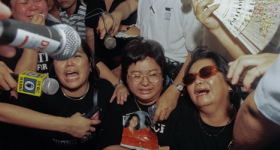Thank you to Gold House, CAPE, Walt Disney Company and Pixar Animation Studios for granting Hyphen Magazine access to the Virtual Gold Open for the film.
This review contains spoilers.
At the turn of the millennium, the world had hope. It also had G-Shocks, Tamagotchis and more boy bands than you could shake a Bop-It stick at. While we’ve seen ’80s nostalgia continue to drive mainstream revivals in music, fashion and film, the 2000s are eagerly waiting in the wings for their proper shine. Walt Disney Pictures' and Pixar Studios' Turning Red looks to be a splashy answer to that.
Arriving exclusively on Disney+ on March 11, Turning Red, directed by Domee Shi (director of the 2019 Oscar-winning short Bao — yes, THAT short), makes history as the first Pixar film to feature a lead Asian character and the first film to be solely directed by a Chinese Canadian woman. Shi, a Toronto native, captures the eclectic, inclusive vibrance of her hometown through a widescreen lens. Did we mention there are giant red pandas on the loose too?
Turning Red tells the story (and tail) of Meilin Lee, a 13-year-old girl who discovers that she transforms into a giant red panda whenever she gets too excited. As she attempts to control her new power, she learns about the red panda’s symbolic connection with her family as well as dark secrets that have haunted them. Newcomer Rosalie Chiang, Sandra Oh, Maitreyi Ramakrishnan and the legendary James Hong round out the cast of vocal talent in the film.
Visually, Turning Red looks like a true marriage of various animation influences and cultural nods: Think Wallace and Gromit stylized through a distinctly chibi lens. The result is indelibly kawaii — a joyful celebration of anime tropes, inside jokes and Asian culture.
From power-up sequences that evoke the heyday of Sailor Moon and Mobile Suit Gundam to facial expressions taken straight from the pages of your favorite Shonen Jump manga, the film’s visual identity winks at “Asian pride” while also celebrating a visual identity unmistakably its own. Elsewhere, the film shines brightest in specific cultural details, from the accessible depiction of a diverse Toronto middle school student body to home cooking scenes that recall Ratatouille in their sumptuous detail. Every element feels intentional and grounded.

(Courtesy of Disney Pictures)
I appreciated how the film makes a concerted effort to showcase strong female characters who have internalized their personal agency in the world long before any supernatural or cosmic introduction. Through the lens of Asian characters in particular, this characterization is warm and encouraging: Mei is introduced from the opening credits as confident and enterprising as she moves through the streets of early 2000s Toronto. The introduction of her red panda alter-ego doesn’t erase those qualities; it enhances them. There’s plenty of fun to be had once the red panda is set loose — a memorable sequence involves Mei and her friends monetizing the red panda as a schoolyard attraction to raise money for overpriced boy band tickets. A more poignant reading of the red panda is how it serves as a fluffy metaphor for the emotional liberation that many Asians feel is unattainable due to familial and cultural factors. In another welcome subversion, hinting at director Shi’s desire to widen the conversation around cultural depictions of Asians, the reveal of the giant red panda does little to scare away Mei’s friends; rather, they accept her wholeheartedly. This unwavering devotion becomes the catalyst toward Mei learning to control her power while also setting up a fascinating, heartbreaking conflict with her mom.
Within the rooftop shenanigans, school yard battle raps and a new jack swing soundtrack that Montell Jordan would readily co-sign, there’s a tacit undercurrent of tension between retaining culture and modernization, highlighted by the multigenerational women in Mei’s family who each have the ability to transform into red pandas — often to mixed results. In one of the most emotionally affective scenes, Mei is transported to a spirit forest (visually similar to the hidden village in Shang-Chi) where she finds her mother (in child form) weeping over physically hurting her own mom when she was in her red panda form. It’s a scene of impossibility: the conversations and healing that often never take place but provide empathy and catharsis for those who may not realize they seek it.
Everywhere else, the film is raucous, spunky fun grooving through boy band tunes with undeniable swagger. Also, we FINALLY get a film that showcases not one but every iteration of the Asian auntie haircut from the 2000s in all their fully rendered Pixar glory. It’s a sight to behold as Turning Red turns toward a future where these stories and experiences can truly run wild.

(Courtesy of Disney Pictures)
Turning Red will be released exclusively on Disney+ on March 11, 2022.










Comments